Below are some of the fundamental facts about neocaridina shrimp that is useful for reference. For more shrimp related posts, click here or go to: https://flyingsalmon.net/tag/shrimp/ to see list of related posts to-date.
Key Parameters Ranges
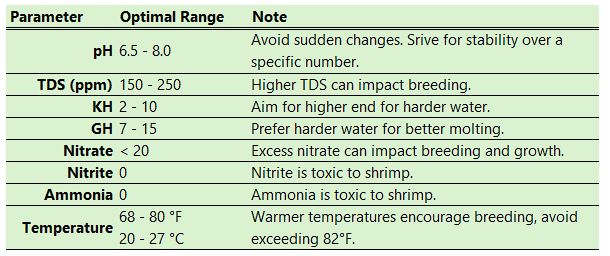
The KH, GH values are shown in degrees (aka dKH, dGH). 1 dHK or GH = 18 ppm (approx.). 1 ppM means that substance is one-millionth of the total amount of water.
Adjusting Parameters
Methods to increase KH:
– Perform water changes with remineralized water at a higher KH. You can use a remineralizer product that contains alkaline minerals, such as Salty Shrimp GH/KH+ or Seachem Equilibrium. For neocaridina shrimp, the optimal KH range is 4 – 6. For caridina shrimp, it is 0 – 11.
– Use a KH-increasing buffer, such as Seachem Alkaline Buffer. This product raises the KH and pH of the water by adding sodium bicarbonate and sodium carbonate. It can be used alone or with Seachem Acid Buffer to adjust the pH to a specific value. Be careful not to raise the KH and pH too quickly, as this can shock your shrimp. Add the buffer gradually and monitor the water parameters regularly.
– Add limestone or other hardscape rocks that contain calcium, such as Seiryu stone or Texas holey rock. These rocks will slowly dissolve in the water and release calcium carbonate, which will increase the KH and pH. However, this method is not very precise and can take a long time to see the effects. It is also not recommended for caridina shrimp, as they prefer soft and acidic water (ok for neocaridina).
– Add crushed coral to your tank, either as a substrate or in a filter media bag. Crushed coral is made of calcium carbonate and will also increase the KH and pH of the water over time. Like the rocks, this method is not very accurate and can take a while to work. It is also not suitable for caridina shrimp.
Methods to increase GH:
– Use a remineralizer product that contains calcium and magnesium, such as Salty Shrimp GH/KH+ or Seachem Equilibrium. You can use distilled or reverse-osmosis water as the base, or mix it with your tap water if it has low GH.
– Add crushed coral to your tank, either as a substrate or in a filter media bag. Crushed coral is made of calcium carbonate and will slowly dissolve in the water and increase the GH. However, this method is not very precise and can take a long time to see the effects. It will also raise the KH and pH of the water, so make sure to monitor them as well.
– Add Wonder Shells to your tank. Wonder shells are made of calcium sulfate and will also increase the GH of the water. Wonder Shells are more soluble than crushed coral and will work faster. They will not affect the KH or pH of the water, but they may release some trace elements that could be harmful to your shrimp in large quantities. Use them (Wonder Shells) sparingly and remove them when the GH reaches the desired level.
Methods to increase TDS:
It’s easier to raise TDS in tank than lowering it because food, fertilizers, minerals will all add to TDS over time.
– Add micro nutrients-iron, zinc, Copper, Manganese, Nickel, Cobalt, Molybdenum, Selenium, Chromium, Iodine, etc. Calcium, magnesium, phosphorus, potassium, chloride, sodium, sulfur, etc. are essential macronutrients for shrimps.
– The fertilizer that you use in your tank can be a good way to raise the TDS of your water.
– You can use Seachem Flourish, Salty Shrimp Mineral to ensure these essential nutrients for your shrimps that will raise your TDS as well as are good for your shrimps’ health.
– You can use limestone to increase TDS that will also help to remove the molting issues.
– You can put leaf litter or driftwood in the tank to increase the number of organic acids in your water.
Methods to decrease TDS:
The best way to lower TDS in a shrimp tank is through a water change, replacing the old water with pure water such as RO (reverse osmosis) water, rainwater, or distilled water.
NOTE: To add minerals to RO/distilled water*, Shrimp King Mineral Salt is a good product.
TDS = GH + KH + Nitrate, Nitrite, chlorine, and other dissolved cations and anions + All dissolved Molecular Compounds
TDS increases as every day you are adding things into your shrimp tanks-shrimp foods, fertilizers, water conditioners, minerals, etc.
High TDS is generally alkaline while low TDS is generally acidic. So, low pH == low TDS. High pH == high TDS
*Distilled water is completely devoid of minerals, where RO water has a little bit, both are purified water. RO can have very low levels of impurities, such as minerals, salts, organic compounds, and microorganism.
Methods to decrease KH, GH:
If your KH and GH are too high, you can lower them by using one of the following methods:
– Perform water changes with remineralized water at the desired parameters. You can use a remineralizer product that contains calcium and magnesium, such as Salty Shrimp GH/KH+ or Seachem Equilibrium.
– You can use distilled or reverse-osmosis water as the base, or mix it with your tap water if the tapwater has lower KH and GH.
– Use soft water that has a lower mineral content, such as rainwater, RO, distilled water, or peat-filtered water. You can collect rainwater in a clean container, or buy RO/DI water from a pet store or online.
– Peat moss can be added to your filter or substrate to release tannins that soften the water and lower KH and GH. However, peat moss can also tint your water with a tea-like color and lower your pH, so use it sparingly and monitor your water parameters regularly.
– Use a KH-lowering buffer, such as Seachem Acid Buffer. This product lowers the KH and pH of the water by adding sodium bisulfate. It can be used alone or with Seachem Alkaline Buffer to adjust the pH to a specific value.
– Be careful not to lower the KH and pH too quickly, as this can shock your shrimp. Add the buffer gradually and test the water parameters frequently.
Methods to decrease Nitrate (NO3) levels:
– Partial Water Changes: Conduct weekly or bi-weekly partial water changes. Regular water changes help remove excess nitrates and maintain safe levels. Aim to keep nitrate levels below 20 parts per million (ppm).
– Aquatic Plants (submersed): Introduce live aquatic plants to your tank. They absorb nitrates during photosynthesis, helping to reduce their concentration. Consider species like Java moss, Anubias, or Hornwort.
– Algae: Algae growth can serve as a marker for nitrate levels. It also actively reduces nitrate concentrations in the tank. If you intentionally grow algae, it can help maintain a healthier environment for your shrimp.
– Cycled Filter Media: Use filter media specifically designed to absorb nitrates. These can be placed in your filter system to enhance nitrate removal.
The Nitrogen Cycle
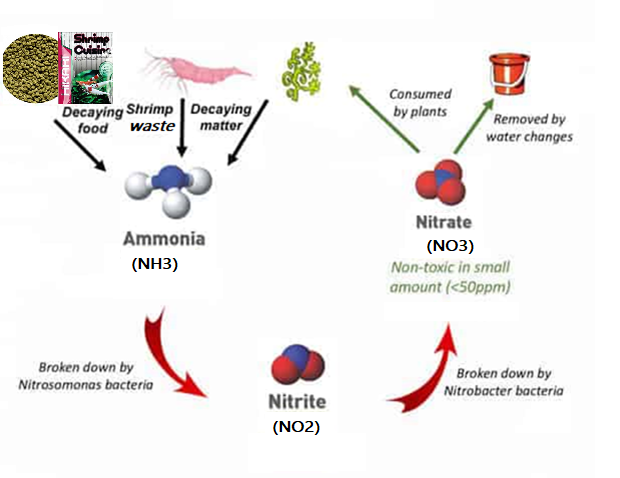
The Lifecycle & Breeding Cycle

How many eggs does a female lay in her lifetime?
Under ideal conditions, a healthy female can breed every 4-6 weeks, potentially resulting in multiple clutches throughout her lifespan, which averages around 1 to 2 years in captivity.
The number of eggs a neocaridina shrimp can lay in her lifetime depends on many factors, such as
- Age and health: Younger and healthier shrimp tend to breed more frequently.
- Water conditions: Optimal water parameters, like temperature and quality, can encourage breeding.
- Presence of males: Females need to mate with males for successful reproduction.
- Stress levels: Stressful environments can negatively impact breeding activity.
A neocaridina shrimp can produce up to 10 batches of eggs per year, with each batch containing 20 to 40 eggs. This means that a single female shrimp can potentially produce 200 to 400 eggs per year.
Neocaridina Anatomy

Identifying Genders
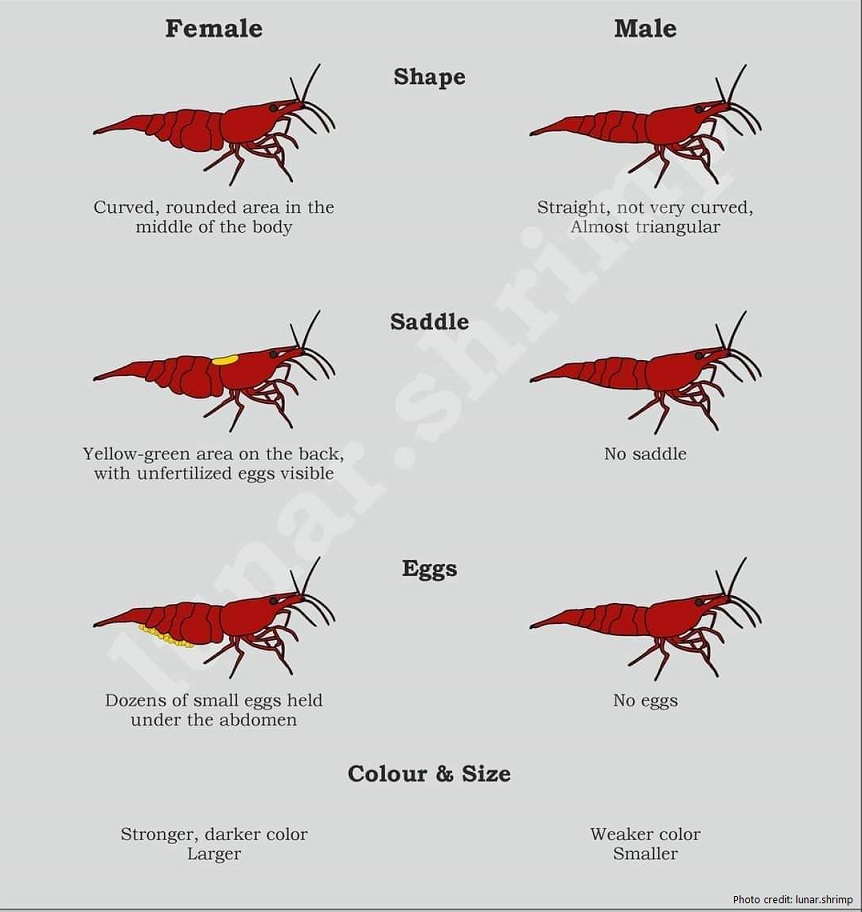
Neocaridina Breeds & Family Tree
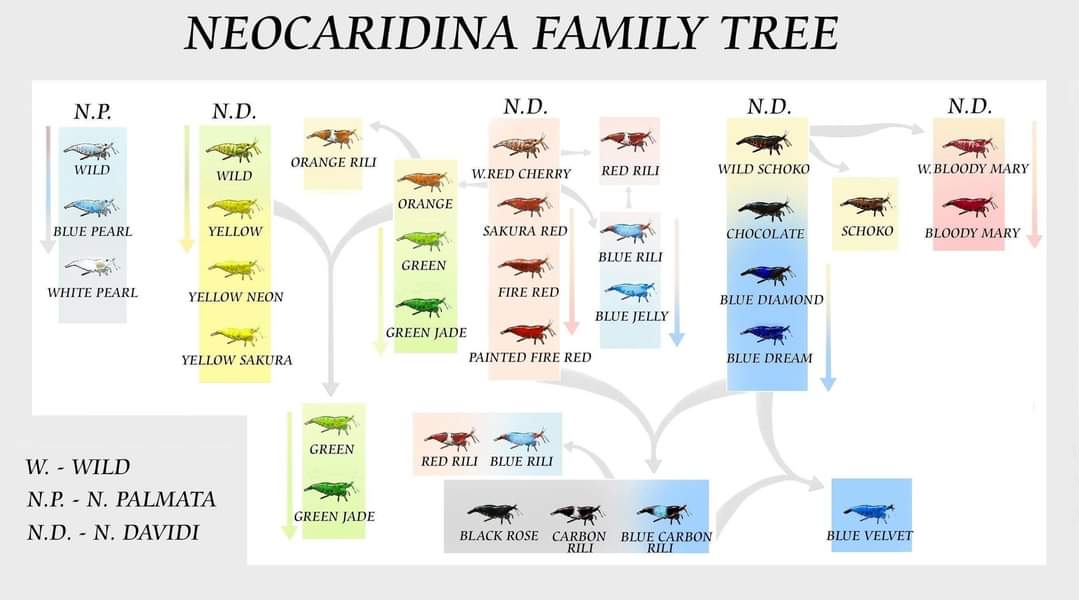
Common Neocaridina Breed Names & Looks (colors, patterns)
The diagram below shows the common and popular lines at high grades (with distinguishable colors and patterns), but there can be many more variations in-between with hybrids and wild variations as neos can cross-breed and the wilds/hybrids typically have no formal mames.
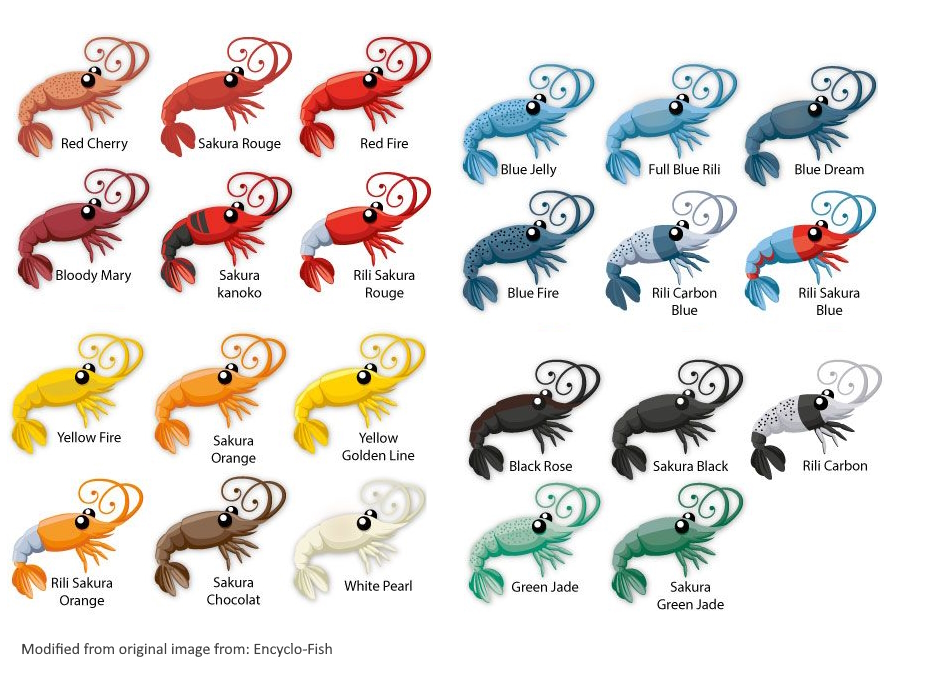
Find more of my posts about shrimp here.
If you want to learn about water parameters and the science and techniques behind them, here is a good intro: